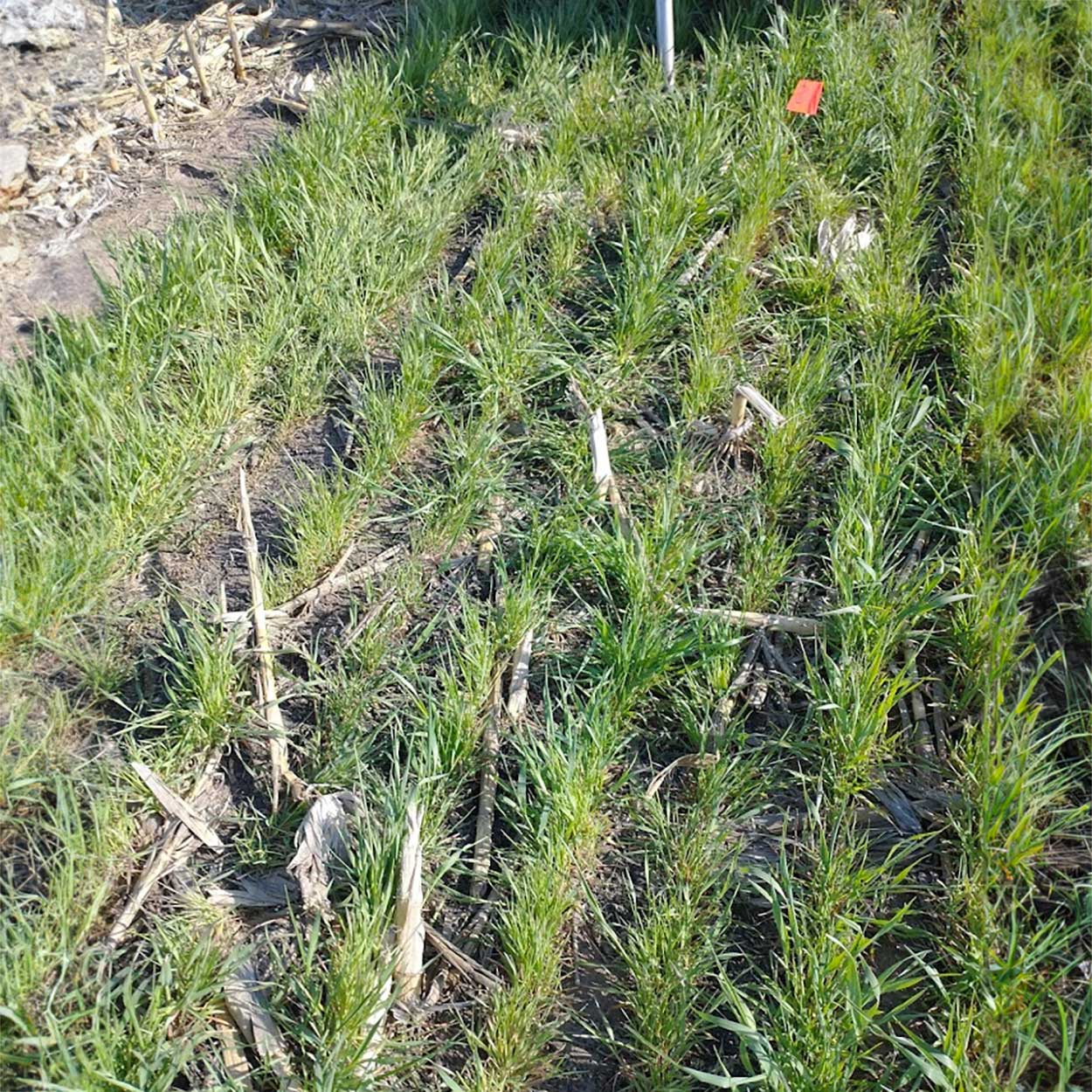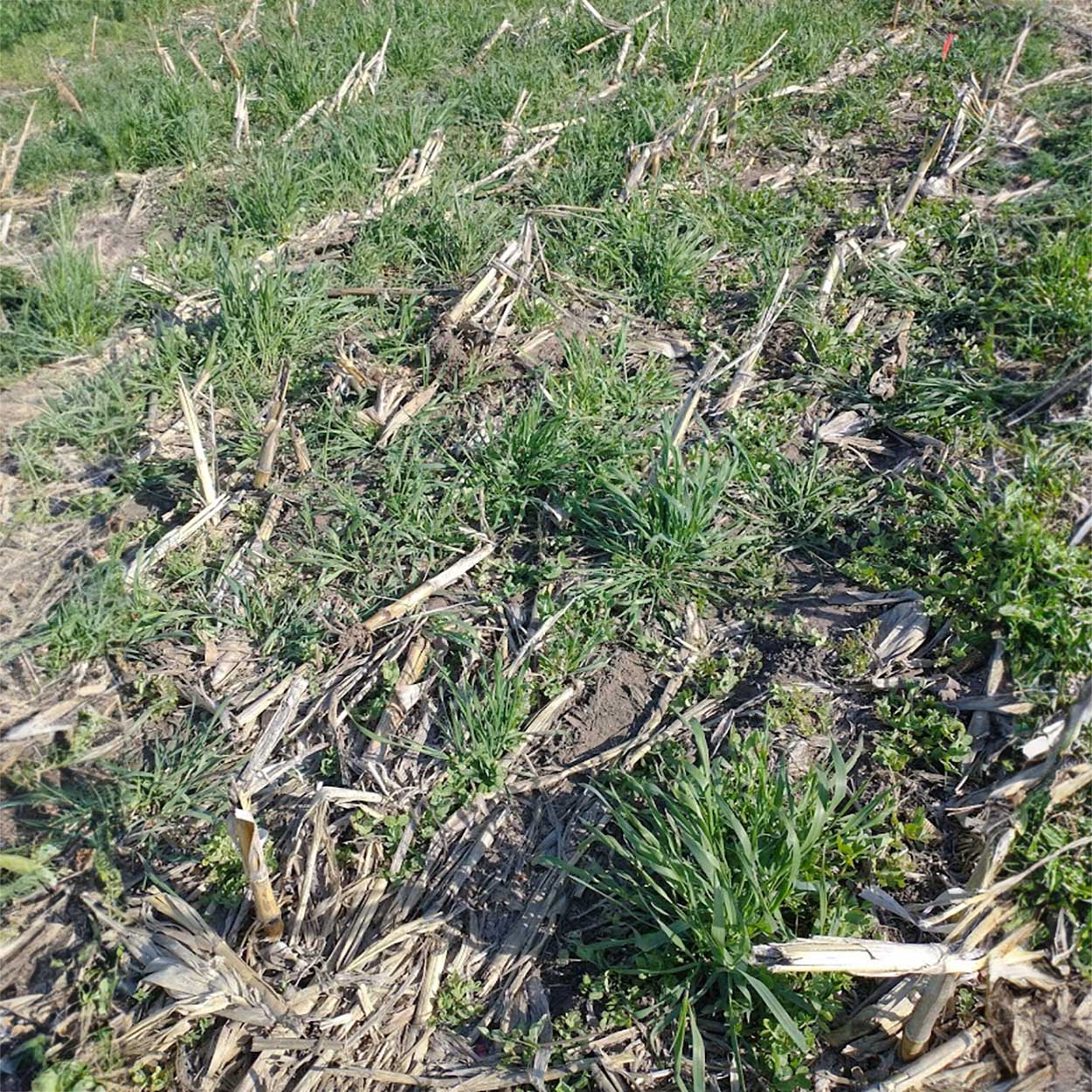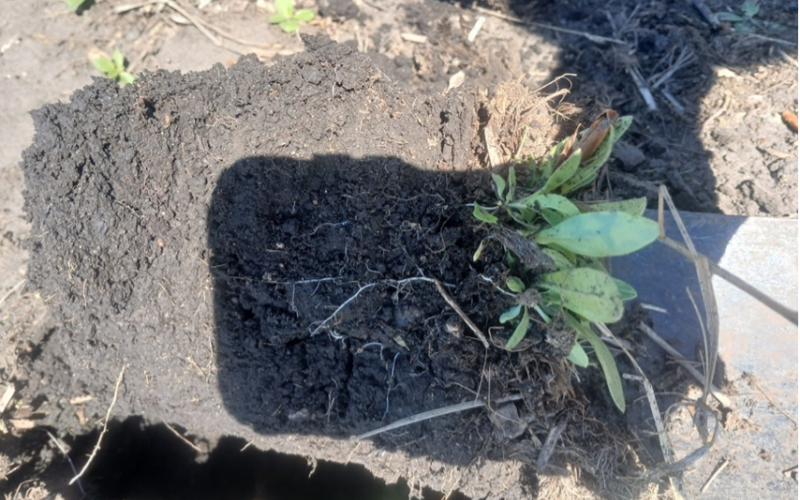Introduction
Cover crops are frequently planted following the harvest of the grain commodity crops. In eastern South Dakota, corn and soybeans are the two main crops that are grown. Corn and soybeans are frequently harvested for grain between mid-September to early November in South Dakota. This leads to limited time for cover crops to grow between the harvest of grain and planting the following commodity crop the next year in late-April to May. This can lead to low biomass production from the cover crop. One way to potentially increase cover crop biomass production is to preharvest plant the cover crop prior to harvesting the main crop. A picture of post-harvest planted cover crops is shown in Figure 1 and a pre-harvest broadcast cover crop is shown in Figure 2 in the "Method" section of this article.
Method
The best way to plant cover crops is to drill the cover crop seed below the soil surface. This method ensures good seed-to-soil contact and places the seed below the surface, where there may be more soil moisture. Also, there is frequently a higher percentage of the cover crop seeds that germinate when the cover crop is planted via a drill than when it is broadcast seeded. A visual example of this can be seen in Figure 1 and Figure 2 below. However, this process is difficult to do when the main crop is around physiological maturity.
Post-Harvest Drill-Planted Cover Crops

Pre-Harvest Broadcast-Planted Cover Crops

Broadcast seeding is another method that can be used to plant cover crops. One method of broadcast seeding cover crops is to spread them from a combine at harvest or with fertilizer in fall. Another way to broadcast seed cover crops is to over-seed or inter-seed with the cash crop. This is frequently done aerially via a drone, airplane, or helicopter; spreading from drops on a high-clearance sprayer; or from a broadcast spreader attached to a high-clearance implement. Preharvest broadcasting the cover crop allows for a longer duration of time for the cover crop to grow in the fall. However, having adequate rain to germinate the cover crop within a week of broadcast is important for cover crop establishment. If the cover crop is not well established, the seeds on the surface may be scavenged by birds and rodents. Cover crop species that have been broadcast seeded into standing crops include cereal rye, annual ryegrass, hairy vetch, clovers (such as red, crimson, white and balansa) and brassicas (such as radish, turnip, rapeseed and camelina). When broadcasting cover crops during later stages of crop growth in South Dakota, choosing winter-hardy species is the best way to optimize biomass production. In regional studies that have been conducted that measured cover crop biomass production when inter-seeded at the same date, drilling the cover crop did increase biomass production of some species or mixtures compared to broadcast seeding (Bich et al., 2014; Noland et al., 2018; Schmidt et al. 2021). Small, seeded cover crops, such as camelina and pennycress, produced similar biomass when broadcast versus drill-seeded (Noland et al., 2018; Schmidt et al., 2021). However, cover crop species with a larger seed size, such as cereal rye or hairy vetch, produced more biomass when drill-seeded compared to broadcast seeded. When broadcasting cover crops, the seeding rate should be 15 to 25% higher than the recommended planting rate of cover crop with a drill.
Biomass Production from Previous Studies
A recent review looked at performance of post-harvest cover crops compared to preharvest-planted cover crops at many locations across the United States. In corn, similar biomass was produced when cover crops were pre-harvest planted versus post-harvest planted (Figure 3). In soybeans more biomass was produced from pre-harvest planted cover crops compared to post-harvest planted cover crops (Figure 3). This may be due to the canopy opening up sooner in soybean than corn to allow for more cover crop growth, and also due to soybeans frequently being harvested for grain before corn.
Also, some cover crop species may establish better when pre-harvest broadcast versus post-harvest drilled. However, most of the cover crop species produced similar biomass when pre-harvest broadcast versus post-harvest drilled (Figure 4).
Biomass by Crop Planted Into

Biomass by Cover Crop Species Planted

The biomass production from winter camelina is higher than for other species due to relatively high spring biomass production in the one study that planted this cover crop (Berti et al., 2017). This data shows that pre-harvest broadcast planting cover crops does not consistently produce more biomass than post-harvest drilling the cover crop. Some studies in nearby states have found in some years that pre-harvest planting of cover crops increases cover crop biomass production, but in others it does not increase cover crop biomass production (Berti et al., 2017; Barker et al., 2018; Batildas 2019; Koehler-Cole et al., 2020; Koehler-Cole et al., 2023 ; Marcos et al., 2023). In trials conducted at Southeast Research Farm near Beresford, South Dakota and other cooperators’ fields across eastern South Dakota, the broadcast-seeded rye at the corn physiological maturity stage produced about 70% of the biomass when compared with drill-seeded rye after corn grain harvest. The rye biomass was measured at the heading stage (late May to early June).
Choosing Whether to Preharvest Broadcast or Postharvest Drill
A decision for producers to make is whether to pre-harvest broadcast or post-harvest drill cover crops. Factors that should be considered are soil moisture content, precipitation outlook, and equipment available to plant the cover crop. If there are dry conditions and not much rain in forecast, planting the cover crop below the soil surface by drill is probably best to increase seed-to-soil contact and reduce the amount of seed that will be destroyed by rodents or birds. If the soil has adequate water content and rain in the forecast, broadcast-seeded cover crops may produce comparable biomass to the post-harvest drilling. Another time when it may be a good idea to have the cover crop aerial broadcast is when conditions are wet in late August and September and the harvest of corn and soybeans may be delayed due to wet field conditions and slow drying of grain. Also, if the producer owns a no-till drill, it may be a better idea to just drill the cover crop to keep the planting cost of the cover crop at a minimum, as there is not a consistent trend of pre-harvest planting winter-hardy cover crops producing more biomass compared to post-harvest planting by drill. However, if wanting to add some cover crops that will winter kill, you would want to pre-harvest broadcast the cover crop. If you are paying for custom planting, you may want to decide on what planting method to use based on soil conditions and weather outlook. Surveys of custom planting rates in nearby states have found average rates for the custom seeding rate of cover crops to be between 14 to 15 dollars for aerial seeding and 20 to 23 dollars for drill seeding (McClure and Jansen 2024 and Plastina et al., 2024).
References
- Barker, J.B.; Heeren, D.M.; Koehler-Cole, K.; Shapiro, C.A.; Blanco-Canqui, H.; Elmore, R.W.; Proctor, C.A.; Irmak, S.; Francis, C.A.; Shaver, T.M.; et al. 2018. Cover crops have negligible impact on soil water in Nebraska maize–soybean rotation. Agronomy Journal, 110, 1718–1730.
- Bastidas, A.M. Cover Crop Introduction into Corn (Zea mays L.)-Soybean (Glycine max L.) Cropping Systems. Ph.D. Thesis , The University of Nebraska-Lincoln, Lincoln, NE, USA, 2018.
- Bich, A.D.; Reese, C.L.; Kennedy, A.C.; Clay, D.E.; Clay, S.A. 2014. Corn yield is not reduced by mid-season establishment of cover crops in northern Great Plains environments. Crop Management. 2014, 13, 1–8.
- Berti, M.; Samarappuli, D.; Johnson, B.L.; Gesch, R.W. 2017. Integrating winter camelina into maize and soybean cropping systems. Industrial Crops Production, 107, 595–601.
- Koehler-Cole, K.; Elmore, R.W.; Blanco-Canqui, H.; Francis, C.A.; Shapiro, C.A.; Proctor, C.A.; Ruis, S.J.; Irmak, S.; Heeren, D.M. 2023., Cover crop planting practices determine their performance in the US Corn Belt. Agronomy. Journal. 115, 526–543.
- Koehler-Cole, K.; Elmore, R.W.; Blanco-Canqui, H.; Francis, C.A.; Shapiro, C.A.; Proctor, C.A.; Ruis, S.J.; Irmak, S.; Heeren, D.M.; Ferguson, R.B. 2020, Cover crop productivity and subsequent soybean yield in the western Corn Belt. Agronomy Journal, 112, 2649–2663.
- Marcos, F.M.; Acharya, J.; Parvej, M.R.; Robertson, A.E.; Licht, M.A. 2023. Cereal rye cover crop seeding method, seeding rate, and termination timing effects corn development and seedling disease. Agronomy Journal, 115, 1356–1372.
- McClure , G.A.; Jansen, J.A., 2024. Nebraska farm custom rates. University of Nebraska Extension.
- Noland, R.L.; Wells, M.S.; Sheaffer, C.C.; Baker, J.M.; Martinson, K.L.; Coulter, J.A. 2018. Establishment and function of cover crops interseeded into corn. Crop Science, 58, 863–873.
- Plastina, A., Johanns, A.; Magwaba, K. 2024. 2024 Iowa farm custom rate survey. Iowa State University Extension and Outreach.
- Schmitt, M.B.; Berti, M.; Samarappuli, D.; Ransom, J.K. 2021. Factors affecting the establishment and growth of cover crops intersown into maize (Zea mays L.). Agronomy, 11, 712.


